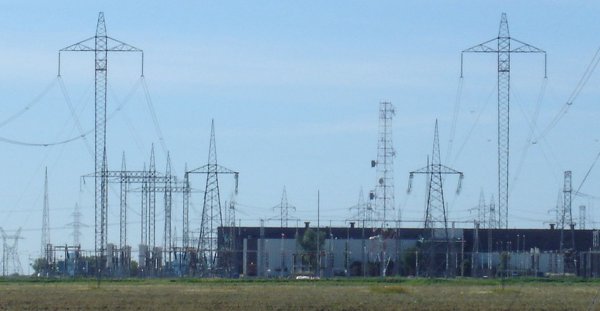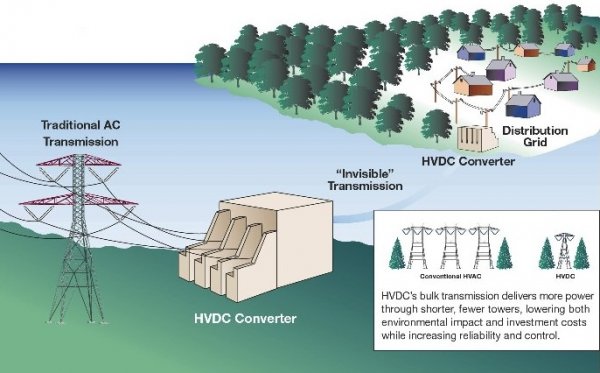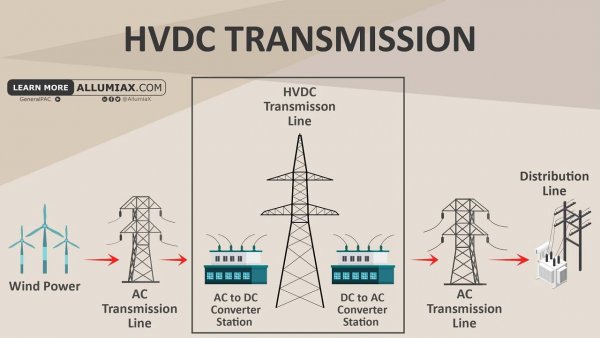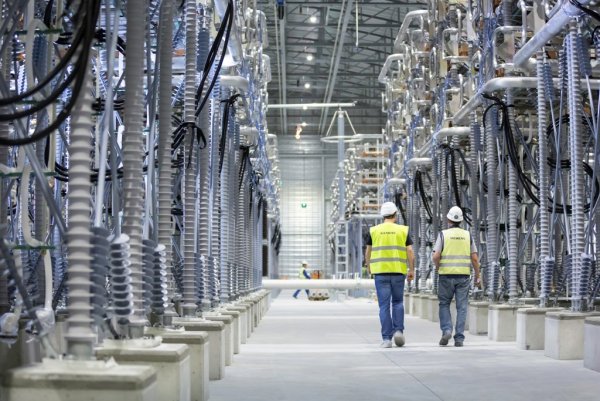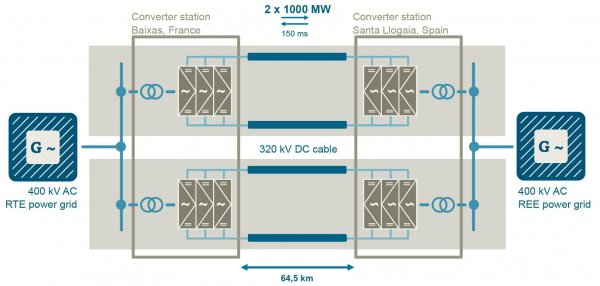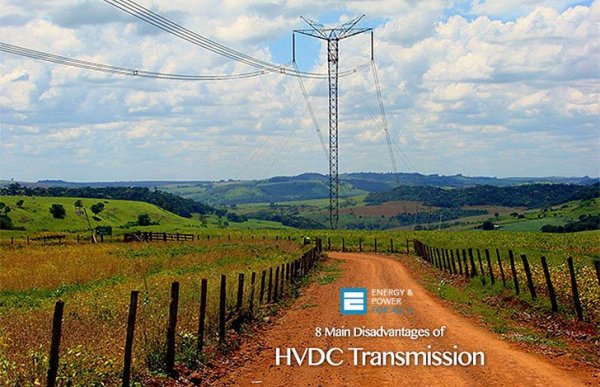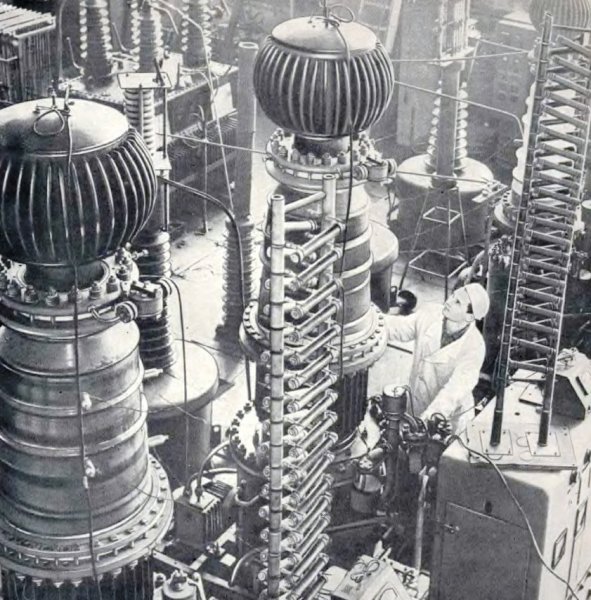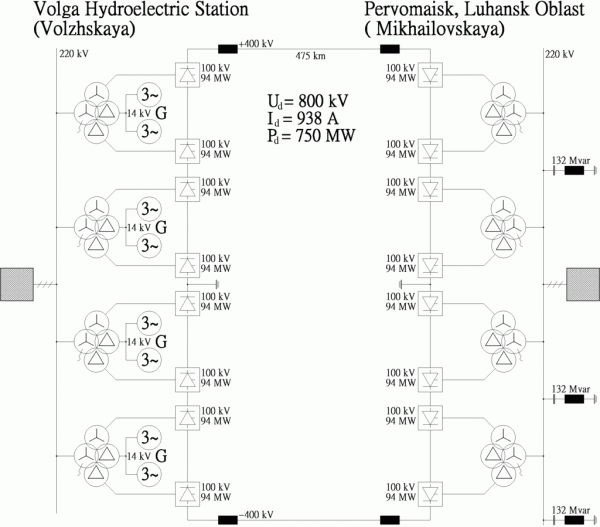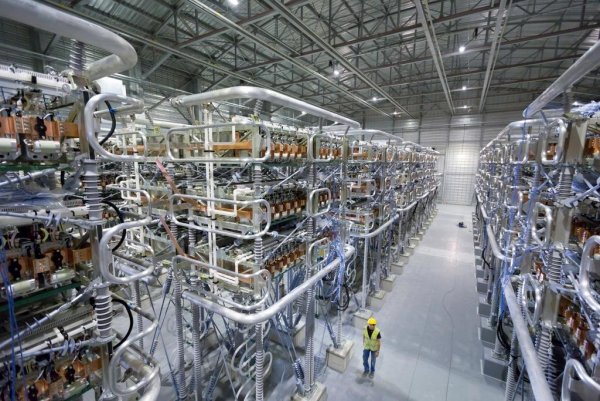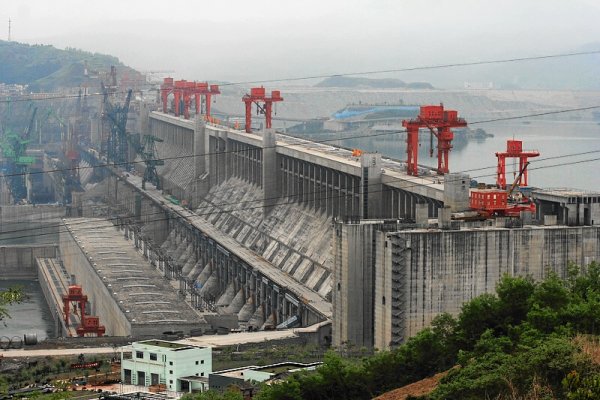Advantages of high voltage direct current transmission lines compared to alternating current lines
Having become traditional high voltage transmission lines, today they operate invariably using alternating current. But have you ever thought about the advantages that a high voltage DC transmission line can give compared to an AC line? Yes, we are talking about High Voltage Direct Current (HVDC Power Transmission) transmission lines.
Of course, for the formation of a high-voltage direct current line, in the first place, converters, which would make direct current from alternating current and alternating current from direct current. Such inverters and converters are expensive, as well as spare parts for them, have overload limitations, in addition, for each line the device must be unique without exaggeration. Over short distances, the power losses in the converters make such a transmission line generally uneconomical.
But in which applications will it be preferable to use it D.C.? Why is high AC voltage sometimes not efficient enough? Finally, are high voltage direct current transmission lines already in use? We will try to get answers to these questions.
You don't have to go far for examples. An electric cable laid on the bottom of the Baltic Sea between two neighboring countries, Germany and Sweden, is 250 meters long, and if the current were alternating, then the capacitive resistance would cause significant losses. Or when supplying electricity to remote areas when it is not possible to install intermediate equipment. Here too, high-voltage direct current will cause less loss.
What if you need to increase the capacity of an existing line without putting in an additional one? And in the case of powering AC distribution systems that are not synchronized with each other?
Meanwhile, for specific power transmitted for direct current, at high voltage, a smaller cross-section of the wire is required, and the towers can be lower. For example, the Canadian Bipole Nelson River Transmission Line connects the distribution grid and the remote power station.
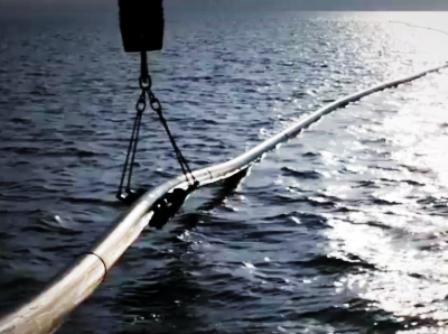
AC power grids can be stabilized without increasing the risk of short circuits. Corona discharges, which cause losses in AC lines due to ultra-high voltage peaks, are much less with DC, correspondingly less harmful ozone is released. Again, reducing the cost of building power lines, for example three wires are needed for three phases and only two for HVDC. Once again, the maximum benefits of submarine cables are not only less material, but also less capacitive losses.
Since 1997AAB installs HVDC Light lines with power up to 1.2 GW at voltages up to 500 kV. Thus a 500 MW nominal power link was built between the grids of Great Britain and Ireland.
This connection improves the security and reliability of electricity supply between networks. Running from west to east, one of the cables in the network is 262 kilometers long, with 71% of the cable on the seabed.
Once again, remember that if the AC current were used to recharge the cable capacitance, there would be unnecessary power losses, and since the current is applied constantly, the losses are negligible. In addition, AC dielectric losses should also not be neglected.
In general, with direct current, more power can be transmitted through the same wire, because the voltage peaks at the same power, but with alternating current, are higher, in addition, the insulation must be thicker, the cross section is larger , the distance between the conductors is greater, etc. Considering all these factors, the corridor of the direct current transmission line provides a denser transmission of electrical energy.
Permanent high voltage lines are not created around them low frequency alternating magnetic fieldas is typical of AC transmission lines. Some scientists talk about the harm of this variable magnetic field to human health, to plants, to animals. Direct current, in turn, creates only a constant (not variable) electric field gradient in the space between the conductor and the ground, and this is safe for the health of people, animals and plants.
The stability of AC systems is facilitated by direct current.Because of the high voltage and direct current, it is possible to transfer power between AC systems that are not synchronized with each other. This prevents cascading damage from spreading. In case of non-critical failures, energy is simply moved into or out of the system.
This further boosts the adoption of high-voltage DC networks, which gives rise to new foundations.
Siemens converter station for a high voltage direct current (HVDC) transmission line between France and Spain
Schematic of a modern HVDC line
The energy flow is regulated by a control system or conversion station. The flow is not related to the mode of operation of the systems connected to the line.
Interconnections on DC lines have an arbitrarily small transmission capacity compared to AC lines, and the problem of weak links is eliminated. The lines themselves can be designed taking into account the optimization of energy flows.
In addition, the difficulties of synchronizing several different control systems for the operation of individual energy systems disappear. Fast emergency controllers included Direct current electrical wires increasing the reliability and stability of the overall network. Power flow control can reduce oscillations in parallel lines.
These advantages will facilitate the faster adoption of high-voltage direct current interaction in order to break large power systems into several parts that are synchronized with each other.
For example, several regional systems have been built in India that are interconnected by high-voltage direct current lines.There is also a chain of converters controlled by a special center.
It is the same in China. In 2010, ABB built in China the world's first 800 kV ultra-high voltage direct current in China. The 1100 kV Zhongdong — Wannan UHV DC line with a length of 3400 km and a capacity of 12 GW was completed in 2018.
As of 2020, at least thirteen construction sites have been completed. EHV DC lines in China. HVDC lines transmit large amounts of power over significant distances, with multiple power suppliers connected to each line.
As a rule, developers of high-voltage direct current transmission lines do not provide the general public with information about the cost of their projects, as this is a trade secret. However, the specifics of the projects make their own adjustments, and the price varies depending on: power, cable length, installation method, land cost, etc.
By economically comparing all aspects, a decision is made regarding the feasibility of building an HVDC line. For example, the construction of a four-line transmission line between France and England, with a capacity of 8 GW, together with onshore work, required about a billion pounds.
List of significant High Voltage Direct Current (HVDC) projects from the past
In the 1880s there was a so-called war of currents between DC proponents such as Thomas Edison and AC proponents such as Nikola Tesla and George Westinghouse. DC lasted for 10 years, but the rapid development of power transformers, necessary to increase the voltage and thus limit losses, led to the proliferation of AC networks. It was only with the development of power electronics that the use of high-voltage direct current became possible.
HVDC technology appeared in the 1930s. It was developed by ASEA in Sweden and Germany. The first HVDC line was built in the Soviet Union in 1951 between Moscow and Kashira. Then, in 1954, another line was built between the island of Gotland and mainland Sweden.
Moscow — Kashira (USSR) — length 112 km, voltage — 200 kV, power — 30 MW, year of construction — 1951. It is considered to be the world's first fully static electronic high-voltage direct current, put into operation. The line does not currently exist.
Gotland 1 (Sweden) — length 98 km, voltage — 200 kV, power — 20 MW, year of construction — 1954. The world's first commercial HVDC link. Expanded by ABB in 1970, decommissioned in 1986.
Volgograd — Donbass (USSR) — length 400 km, voltage — 800 kV, power — 750 MW, year of construction — 1965. The first stage of the 800 kV DC power line Volgograd — Donbass was commissioned in 1961, which was noted in the press at that time as a very important stage in the technical development of Soviet electrical engineering. The line is currently dismantled.
Testing of high-voltage rectifiers for a direct current line in the VEI laboratory, 1961.
Line diagram of high voltage direct current Volgograd — Donbass
Look: Photographs of electrical installations and electrical equipment in the USSR 1959-1962
HVDC between the islands of New Zealand — length 611 km, voltage — 270 kV, power — 600 MW, year of construction — 1965. Since 1992, reconstructed АBB… Voltage 350 kV.
Since 1977until now all HVDC systems have been built using solid-state components, in most cases thyristors, since the late 1990s IGBT converters have been used.
IGBT inverters at the Siemens converter station for the high-voltage direct current (HVDC) transmission line between France and Spain
Cahora Bassa (Mozambique - South Africa) — length 1420 km, voltage 533 kV, power — 1920 MW, year of construction 1979. First HVDC with voltage over 500 kV. ABB repair 2013-2014
Ekibastuz — Tambov (USSR) — length 2414 km, voltage — 750 kV, power — 6000 MW. The project began in 1981. When it is put into operation, it will be the longest transmission line in the world. The construction sites were abandoned around 1990 due to the collapse of the Soviet Union and the line was never completed.
Interconnexion France Angleterre (France — Great Britain) — length 72 km, voltage 270 kV, power — 2000 MW, year of construction 1986.
Gezhouba — Shanghai (China) — 1046 km, 500 kV, power 1200 MW, 1989.
Rihand Delhi (India) — length 814 km, voltage — 500 kV, power — 1500 MW, year of construction — 1990.
Baltic cable (Germany - Sweden) — length 252 km, voltage — 450 kV, power — 600 MW, year of construction — 1994.
Tien Guan (China) — length 960 km, voltage — 500 kV, power — 1800 MW, year of construction — 2001.
Talcher Kolar (India) — length 1450 km, voltage — 500 kV, power — 2500 MW, year of construction — 2003.
Three Gorges — Changzhou (China) — length 890 km, voltage — 500 kV, power — 3000 MW, year of construction — 2003. In 2004 and 2006.2 more lines were built from the "Three Gorges" HVDC hydroelectric plant to Huizhou and Shanghai for 940 and 1060 km.
The world's largest hydroelectric power station, the Three Gorges, is connected to Changzhou, Guangdong and Shanghai by high-voltage direct current lines
Xiangjiaba-Shanghai (China) — the line from Fulong to Fengxia. The length is 1480 km, the voltage is 800 kV, the power is 6400 MW, the year of construction is 2010.
Yunnan — Guangdong (China) — length 1418 km, voltage — 800 kV, power — 5000 MW, year of construction — 2010.

